Allegro
Women’s Lives, Women’s Stories
Women's History Month 2023
Volume 123, No. 3March, 2023
(If you’re reading this story on a phone or mobile device, rotate to horizontal or “landscape” view to see the photo montage below)
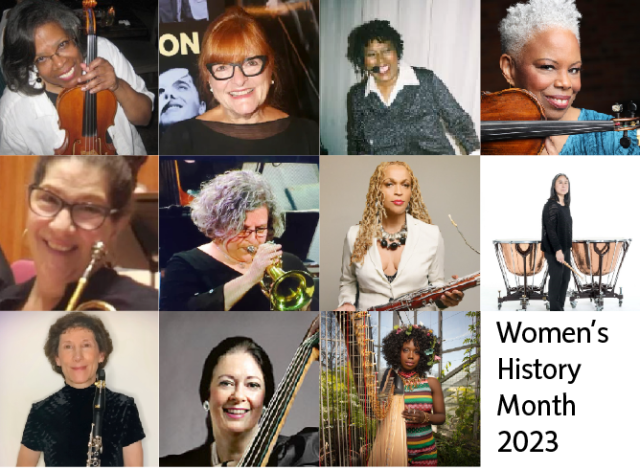
TOP ROW (from left): Sandra Billingslea, Kristen Blodgette, Bernice Brooks, Regina Carter (photo by Chris Dukker) / MIDDLE ROW: Lorraine Cohen, Jami Dauber, Monica Ellis, Maya Gunji (photo by Matt Dine) / BOTTOM ROW: Chris MacDonnell, Orin O’Brien, Brandee Younger
In celebration of Women’s History Month, Local 802 presents a series of interviews with a few of the many women who have forged successful careers in historically male-dominated and/or white male-dominated areas of our business. Many of these women not only broke through gender and racial barriers but also play their instruments in traditionally unusual settings or genres.
We asked these questions and each addressed them as she/they chose. We then listened as they shared their own oral histories. What follows here is a narrative representation of each of these conversations.
- How old were you when you started? What was your first instrument? Why did you choose it?
- Who were the greatest influences on your musical life
- What are some standout experiences?
- What are some of the greatest challenges? How did the fact that your field/instrument is traditionally white male dominated impact you?
- Anything else you’d like to tell us?
Recurring themes run through this series of interviews. While gender bias and racial discrimination was, and is, a reality of life in the music business, the women interviewed here refused to let issues related to those stop them. They achieved success in spite of systemic prejudice. In some cases, they ignored it. In others, they were unaware of it. In still others, they got angry and got on with their jobs. All of them give credit to supportive colleagues, family, and teachers for making their creative lives possible. There was also a lot of talk among these women about luck and gratitude. They felt grateful to find encouragement from mentors along the way. They felt lucky to win jobs and engagements. They felt lucky to have achieved success following their chosen avenues in music. Certainly, we should all be grateful to these eleven women and many others like them for paving the way forward for the rest of us.
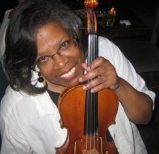 Sandra Billingslea, violin (click for bio and to view this interview as a stand-alone story to share)
Sandra Billingslea, violin (click for bio and to view this interview as a stand-alone story to share)
I started playing piano when I was seven years old, but what attracted me to classical music was seeing the dying swan performed on the Ed Sullivan Show to The Swan from The Carnival of the Animals by Camille Saint-Saens when I was four. Soon after, I began taking ballet classes and kept up with those classes through high school. I studied piano with Mrs. Odessa Simpson, who was Canadian and from the Royal Conservatory. She was Black but very light skinned and could have passed for white in segregated Detroit but was proud of her heritage and refused to turn her back on it. I started violin when I was twelve in the Detroit public schools with Mr. Miller. I had been playing for a year when I heard the Mendelssohn Violin Concerto at a concert. That is when I decided that was what I wanted to do.
When the Detroit public schools desegregated I was transferred to another school which did not have a string teacher. We string students did the best we could. Many families discouraged girls from taking private lessons because they were expected to marry and start families after high school or because the families didn’t have the money.
My family always expected me to go to college. Opportunities for Black females without a college degree in the 50s and 60’s were very slim: domestic work, elevator operator if you were light skinned and pretty enough, beautician, waitress, nursing with extra schooling, maybe receptionist or secretary in a Black owned business. Nothing I was interested in. In public high school, I started private lessons. Michigan State professor Lyman Bodman heard me play in a Detroit festival and got me a full scholarship to Michigan State University, where I received my Bachelor’s and Master’s degrees. My early training had left me with some technical problems which we worked hard to fix.
One of the greatest influences on me was Mrs. Simpson, my Canadian piano teacher. She insisted I learn how to sight read anything placed in front of me, especially the rhythms.
I loved playing charts with jazz and Latino stars in string sections, but classical music was always my passion and focus. When I came to NY, I was hired as organist for a church in Jamaica Queens, thanks to my exposure to choir repertoire in Detroit. Howard Roberts, a Broadway conductor, heard me play there and hired me for the 1976 revival of Guys and Dolls, my first Broadway show.
I joined Gayle Dixon, violinist and advocate, in The String Reunion with Noel Pointer and Akua Dixon. Gayle was instrumental in giving me a leg up on my career.
Standout experiences include hearing that Mendelssohn concerto from the balcony of Ford Auditorium with my father, who had just worked a 16 hour shift with the Detroit Street Railway. Our free tickets were provided by Jackie Kennedy Onassis as part of her effort to make classical music accessible to everyone.
Career highlights include playing with the Dance Theatre of Harlem Orchestra at the Uris Theatre (my first union gig); playing at a Mahler Festival in Austria in 1985 performing the Ninth Symphony and visiting Mahler’s home; my first trip to Japan with the NY Pops and subsequent trips with The New York Ragtime Orchestra. And I was busy on the club date scene in the 1970’s and 80’s. Lena Horne came over to me and sang Honeysuckle Rose on my first club date in NYC! Playing for Sammy Davis Jr., Bill Cosby, Diane Carrol, Cleo Lane, Frank Sinatra, Joe Williams and so many more was fun, challenging and a source of income I couldn’t imagine growing up in Detroit.
There were many painful experiences. As a youngster I won the audition for a front chair at the Detroit District Orchestra. Just before the start of the performance, I found my violin moved, my chair gone, and all the white violinists moved up. There was nothing I could do except get a chair and sit in the back of the section. When I won concertmaster in my high school orchestra, the rest of the section, all white and people I thought were my friends, walked out and refused to play. Black students were actively discouraged from playing violin and from playing classical music, not just by white adults but by some members of the Black Power movement who thought we should be playing jazz instead of “white people’s music.” I felt affirmed in my chosen path much later by Rahsaan Roland Kirk who told me, “If you don’t feel it, it won’t come out of your horn.”
The culture in the music industry was racist and misogynist. When Sanford Allen got me onto a jingle, the conductor/arranger on the date made it clear he didn’t want any women there, saying this was a professional job and we belonged in the kitchen. Sanford lost that contract because he hired women. Other contractors would only hire women if they were sleeping with them or they were someone’s girlfriend or wife. In the revival of The King and I with Yul Brynner, the conductor would hold up a Playboy centerfold for Brynner at the same point in every performance. On my first job with Earl Shendell, a contractor, he put his hands where he shouldn’t. I was so incensed, I grabbed a newspaper, rolled it up and began beating him with it, screaming at him. All of a sudden, I noticed he was laughing. He loved that I had stood up for myself and would take none of his nonsense. I was very surprised. I’d expected an immediate dismissal. None of the other men tried anything with me after that, although I was propositioned often with promises for work, recordings, etc. Red Press was one contractor who helped change the dynamic in Broadway pits by hiring women.
I am now on the board for the Harlem Chamber Players and I also play with them regularly. They are a diverse ensemble–they welcome everyone and it is gratifying to see. I also just came back from the Color of Music Festival in Charleston, SC, (an international festival of Black and Latino classical musicians).
I come from a family of union members and supporters. My grandfather helped found the Electricians Union in Wetumpka Alabama in 1910. The union was integrated but the neighborhoods the electricians serviced were segregated: white electricians going to white neighborhoods and Black electricians servicing the Black neighborhoods.
I attended the Workers Institute at Cornell’s ILR School to be better able to serve my community and union, but because of administrative changes at the union and in my personal life I didn’t follow through.
I was always determined to stick with my path, despite all the naysayers. And along the way, there were a number of people who had my back, even when the going was rough. I am grateful for the many wonderful experiences I have had.
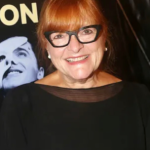 Kristen Blodgette, conductor/musical director (click for bio and to view this interview as a stand-alone story to share)
Kristen Blodgette, conductor/musical director (click for bio and to view this interview as a stand-alone story to share)
I started piano at age four. It was my place of solace. I was originally attracted to it after seeing and hearing my older sister’s friend play. I wanted to be like her. My father took lessons with me and supported me as we went along.
My main influences were Broadway show albums and Leonard Bernstein’s Young People’s concerts. I was obsessed with Barbra Striesand and wrote to her every day. Growing up in Cleveland, Ohio, I was lucky my middle and high schools had excellent music programs. I played the French horn in addition to piano. I knew at age 10 I wanted to be a musician.
I feel fortunate that my standout experiences are the ones I’m in at the moment. Conducting Phantom of the Opera which has been so close to my heart is one. Working with Glenn Close and the amazing orchestra on Sunset Boulevard was another. When I was very young I played for Cy Coleman and toured the country playing one of the two piano parts for Barnum.
Challenges have mostly been internal. I know I have colleagues who were denied opportunities because of their gender but that never happened to me. I was very lucky to get the gigs. But as a young conductor it took me a while to figure out how to show up and be a leader in a setting for which I didn’t have a role model. In trying to lead in a balanced way I felt I had to wear a kind of cloak of strength that didn’t really reflect who I am. As I gained more experience I learned that the best way to show up is to be my authentic self. It feels better balanced now.
I am sad that Phantom is closing. It has been a wonderful run and a wonderful place to call home. I will miss all of it.
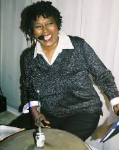 Bernice Brooks, drums (click for bio and to view this interview as a stand-alone story to share)
Bernice Brooks, drums (click for bio and to view this interview as a stand-alone story to share)
I started drums when I was 18 years old. I grew up in Mississippi and then moved to Chicago. My parents played a lot of gospel music like Mahalia Jackson and my aunts and uncles played a lot of blues and jazz. My parents worried that if I became a drummer I would play in juke joints and hang out with the wrong types. I always loved to dance–still do and I was attracted to the drums because I was able to recognize tunes by hearing the rhythms tapped out on a table. When my parents came to see Mama, I Want to Sing, my first show, they were reassured that I was not involved in juke joints and influences of drugs.
My musical influences were Art Blakey, Max Roach, Tony Williams, Stevie Wonder, James Brown and 70s funk and soul music in general
The two standout experiences for me were performing with the Berlin Philharmonic with Taylor Mac (I never dreamed I’d play with a full orchestra like that) and getting a Cultural Community Leadership citation from my New York City Council member.
I found the attitude toward my being a drummer in many settings was about 50-50 among men. Half were helpful and the other half were not. In jam sessions there was always the unspoken and sometimes spoken question: “can she play?” I particularly want to shout out to Larry Ball, a bass player who mentored me, supported me and promoted me.
I also want to shout out to Kit McClure, whose big band I worked with for years and Vy Higginsen and Ken Wydro, who produced Mama I Want to Sing. I am also grateful that I was able to hone the skill set I have that has taken me around the world. I have expanded that skill set and now I produce my own TV show on the BRIC network in Brooklyn. When traveling to Germany and other European countries, I noticed they have a nice setup for their artists of all genres. I wish for all upcoming artists of all genres here in America that something similar would eventually happen here to support the arts. This support in Europe was particularly apparent during Covid.
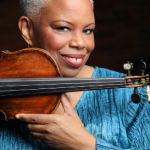
Photo by Chris Dukker
Regina Carter, violin (click for bio and to view this interview as a stand-alone story to share)
I started on the piano by accident! When I was two years old, my older brothers were taking lessons. During one, I sat down at the piano and played one of the pieces they were learning. Their teacher was pretty amazed and I began lessons too. But I wasn’t interested in learning to read music, I just wanted to make-up my own songs and my teacher thought better I should wait a couple of years. At four, I began Suzuki violin classes and loved it.
I’d say my first strong influence was my grandmother. She graduated with a degree in piano pedagogy in 1915! Because of her, both education and music were very important in my household growing up.
In high school, I played in masterclasses with Itzhak Perlman and Yehudi Menuhin. Both made big impacts on me. Particularly Menuhin. When my school music teacher commented that I was ruining my chances by playing jazz all the time, Menuhin picked up his violin and played a blues riff and told my teacher, “Leave her alone.”
My introduction to jazz was via jazz violinists Stephane Grappelli, Noel Pointer and Jean-Luc Ponty and later, the great Ella Fitzgerald. Their recordings blew me away, thus began my love for and desire to explore this music. In the late 80’s, I applied for and received a NEA grant to study with John Blake, another great jazz violinist.
I remember many standout experiences! Touring with Wynton Marsalis and the Jazz at Lincoln Center orchestra performing Blood on the Fields really put me on the map. As did touring with Ray Brown. Performing concerts in Genoa and New York with Paganini’s violin and making a recording with his Il Cannone were also incredible experiences.
I’ve gotten more pushback for playing jazz violin than for anything else in my career. Several radio stations would not play my first CD stating their listeners didn’t like jazz violin. Radio program director, Steve Williams was instrumental in helping me with that hurdle. I have had challenges on my journey, as we all do but I have kept my focus on getting the job done. My mother likened challenges to speed bumps and always said speed bumps determine if you really want something. And I have always looked at things like bias and discrimination as speed bumps I needed to move past. Because playing jazz was something I really wanted. I’ve also learned over the years to set boundaries. As a woman, particularly as a black woman, giving myself permission to put myself first and to say no came late in life and I’ve come to realize, I don’t have to accept everything, I can say no. That is so important to remember.
I’m appearing at the Kaufmann Concert Hall, 92NY on April 28th. Hope to see all my 802 brothers and sisters there!
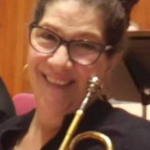 Lorraine S. Cohen, trumpet (click for bio and to view this interview as a stand-alone story to share)
Lorraine S. Cohen, trumpet (click for bio and to view this interview as a stand-alone story to share)
I was nine years old when my father offered me a dollar to play the trumpet. He said I was full of hot air. I accepted his challenge. Unfortunately, I really wanted to play the flute. Come to think of it, I still do.
My first teacher was Donald Stroud. I studied with him from fourth grade to 12th grade and he gave me so much self-confidence. Seymour Rosenfeld (Philadelphia Orchestra) believed in me through my years at Temple University and beyond. My parents (in spite of the “hot air” crack) were constantly at my side and my biggest fans. I feel very lucky to have had their support and encouragement.
I was blown away by Itzhak Perlman the first time I heard him play. He made me feel that leaving your physical body was the only way to perform. I stopped feeling self-conscious once I realized that. And listening to Joan Sutherland’s beautiful long singing phrases strongly influenced the way I approached playing the trumpet. I wanted to sound like that.
Two standouts: the day I won the audition for principal trumpet of the Israel Philharmonic after auditioning for Zubin Mehta and the day I appeared on the Mothers’ Day episode of Maury Povitch and my young son, Adam, introduced me and sat on stage with me through the taping of Flight of the Bumblebee. That last part was terrifying!
Challenges. Here’s where things turn dark. My greatest personal challenge was keeping myself from bringing lawsuits or charges against all the colleagues and arts administrators who committed multiple and constant acts of aggression against me. I was told by Gilbert Johnson (Philadelphia Orchestra) after I auditioned for Curtis that I had no future as a woman trumpet player. (He accepted me the second time I auditioned and he made me first call sub with the Philadelphia Orchestra.) I’ve had things thrown at me in performance. I’ve been purposely shoved while playing. I’ve won auditions but had to watch the jobs go to others — always men. I was the first call sub on a Broadway show for decades and saw the job finally go to a man. I’ve been told by contractors that everyone voted for me but the lead player, who wouldn’t sit next to a woman. Many times I wanted to pursue charges but I knew that I would be punished for doing so and my career meant too much to me to risk it. So, I adopted the ultimate defense. I promised myself I would always play better than any of them! I focused exclusively on that goal. I honed my skills and prepared like hell for every gig.
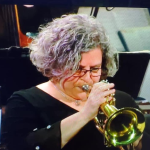 Jami Dauber, trumpet (click for bio and to view this interview as a stand-alone story to share)
Jami Dauber, trumpet (click for bio and to view this interview as a stand-alone story to share)
My musical life began when I was three years old and started playing the piano. My dad played the piano, so I guess that’s what drew me to it. Then in the fourth grade, I had the opportunity to join the concert band and I chose to play percussion. From an early age, I was exposed to a lot of music at home — everything from Count Basie, Maynard Ferguson to horn bands like Chicago and Blood Sweat & Tears, to Bob Dylan, Led Zeppelin and Oscar Levant! There was something about the sound of a horn section that drew me to the trumpet, so I switched in fifth grade.
The biggest influences on me besides my parents were my band directors, who helped form my basic musicianship. I also took private lessons from some great teachers along the way, most notably Don “Jake” Jacoby and Laurie Frink. I think about them both every time I pick up the horn.
Many of my standout experiences since moving to New York in 1994 have been with The DIVA Jazz Orchestra, led by Sherrie Maricle. I’ve been a member of DIVA for 29 years and we’ve performed all over the world. A notable memory was when we performed with Nancy Wilson at Tanglewood — our lead trumpet player, Liesl Whitaker, was eight months pregnant at that concert and was blowing high A’s like it was nothing — she’s my hero! Most recently, DIVA has been touring with The Manhattan Transfer and I’m still buzzing from playing Birdland with them — that was a real career highlight for me. Other significant DIVA experiences include our longtime collaboration with the legendary Maurice Hines. He is a consummate showman from whom I learned a great deal — and I met my wife, woodwind doubler Amy Griffiths, on one of those gigs. DIVA is celebrating our 30th Anniversary this year!
Another standout was playing with The Who at Madison Square Garden — the sound of the crowd when the lights went down — nothing like I’ve ever experienced! And after subbing for countless shows on Broadway for over 20 years, Jason Robert Brown hired me for my first Broadway show, Honeymoon in Vegas — that band was a blast, and getting to play with Tony Kadleck and those other incredible musicians every day was a thrill.
A recent highlight was participating in a project with Victor Goines. Victor was commissioned to write and perform a suite for Woodlawn Cemetery, a national historic landmark in the Bronx where many musicians, artists, writers, etc. are laid to rest. Victor intentionally assembled a diverse group of outstanding musicians for this project. We performed the suite in June and then went into the studio in late December. I am also really excited to be playing in a 30-piece orchestra for the upcoming production of Camelot at the Vivian Beaumont Theatre at Lincoln Center.
I get asked what challenges I’ve had being a female trumpet player. Honestly, I didn’t notice anything particularly “unusual” about that until I won first chair in the All-State high school symphonic band in Florida. The last chair trumpet player was so bothered by the audition results that he started a rumor that the results had been reversed and I was supposed to be last chair, and he was supposed to be on the first chair. My mom gave me a t-shirt when I was around 10 years old that said, “Girls Can Do Anything Boys Can Do, But Better,” which probably helped instill a sense of confidence and pride.
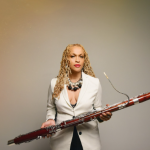 Monica Ellis, bassoon (click for bio and to view this interview as a stand-alone story to share)
Monica Ellis, bassoon (click for bio and to view this interview as a stand-alone story to share)
I started on clarinet in second grade at seven years old. My father, Clarence Oden was a professional saxophone player who had his own band in Pittsburgh, where I grew up. There was a clarinet sitting around the house so even though the Pittsburgh schools started band in the third grade, I was able to start in second grade because I had a clarinet. In the sixth grade I began playing saxophone and piano and I kept up with both through high school. In the eighth grade my band director handed me a bassoon to try and I took to it. I was studying clarinet with a woodwind doubler who suggested I study bassoon with Mark Pancerev, bassoonist with the Pittsburgh Symphony. Once I began to play bassoon with the Pittsburgh Youth Symphony I was hooked and excited about the bassoon. I still play a little alto and soprano saxophone and played some soprano on an Imani Winds recording.
The greatest influences on me were Mark Pancerev of the Pittsburgh Symphony and my parents, Clarence Oden and Marlene Ellis. Also my bassoon teacher at Oberlin, George Sakakeeny and my teacher in NYC, Frank Morelli. The support of my family has always been very important. They made sure I never felt like I was alone; they always stood behind me.
One of my standout experiences was going to Panama twice during Oberlin’s Winter Term which is the month of January. A colleague named Nicolasa Kuster, who was a few years ahead of me at Oberlin, founded the Panama program while still an Oberlin student. Oberlin conservatory students would go to Panama to play and teach students there. This planted the seed of community outreach in me. Other standout experiences include various summer festivals where close musical ties are formed and nurtured.
There was always the challenge of being the “other” as a Black bassoonist. I feel I was unaffected by this largely because of the support system from my family and also because I am just not someone who lets naysayers define me.
The more immediate challenges are about Imani Winds making our way in a world where artistic directors always seem to be looking for string groups, not a group of winds. In the beginning, because the group was founded as a wind quintet made up of all people of color, we had a steeper hill to climb to be taken seriously as a qualified, excellent chamber group. But we work hard at excellence because that is what we want, not just because it removes all doubt about excellence. The group has been together over two decades and has always had a culture of excellence because the members expect nothing less.
The culture of excellence is a common element between my family and Imani Winds. It has always just been an expectation. Both have also been a support system for me as I make my way. I am also grateful that my nine-year-old son can see what I am doing, how hard I work and how rewarding it is. He often comes on the road with me.
I love the life I lead.
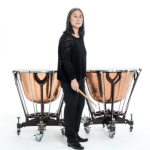
Photo by Matt Dine
Maya Gunji, percussion (click for bio and to view this interview as a stand-alone story to share)
I began studying the drums when I was eight. I had started on piano but wanted to move to the drums. There was no one reason that I chose drums. I just felt an immediate and intangible attraction to them. And, at eight years old, I had no concerns about whether a girl ‘should’ play drums or not. My parents said yes (Very good parenting or very bad? Who knows?) and that was all that mattered.
I’d say two of the most profound influences were my two NY teachers, Scott Stevens (in the MET Orchestra at the time) and Buster Bailey (then in the NY Philharmonic). They were not just musical influences; they were both really life mentors. Apart from them, and more broadly, I have to say that every person I’ve ever played with was an enormous influence on me. Good, bad, it didn’t matter. I learned something valuable from every colleague along the way.
Three musical experiences immediately come to mind as ‘standouts’. The first was playing with the heavy metal band, Metallica, at Madison Square Garden about 20 years ago. The Orchestra of St. Luke’s was hired to back them up for their NY show. I was already a huge fan of the band and my secret ‘fan-girl’ persona exploded as I realized I was on stage with one of the greatest rock bands ever and playing to 17,000 screaming fans at the Garden. The second was the first time I played at the Musikverein in Vienna (with Orpheus). And third was playing Zimmerman’s Die Soldaten at the Armoury at the Lincoln Center Festival. It was a difficult, powerful opera. For all three, the music, combined with the settings, made for unforgettable evenings.
When I consider the challenges I faced, I have to confess that I feel they are the same challenges any musician faces in any workplace. Being prepared, behaving professionally, and being a good colleague have been my focus. And my field has changed a lot over the last 20 years; there are now plenty of female drummers and percussionists in important positions around the country. But, even when I was starting out — and could be I was just unaware or naive — I didn’t think of myself as a “female” percussionist. Probably because I was so fortunate along the way to have supportive colleagues who never made me feel I didn’t belong. They accepted me (as long as I did a good job) and that was the end of the story.
Last thoughts? I love my colleagues and I love NY. I would not have been able to have the kind of career I’ve had in any other city in the world.
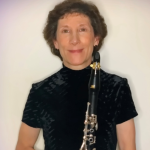 Chris MacDonnell, woodwind doubler (click for bio and to view this interview as a stand-alone story to share)
Chris MacDonnell, woodwind doubler (click for bio and to view this interview as a stand-alone story to share)
I was eight and a half when I started playing the clarinet, which was my first instrument. My parents used to take me to symphony concerts and my mother, who favored string instruments, would point out the violins. I was always more interested in the woodwinds, especially the bassoons and clarinets. When it came time at the end of third grade to choose an instrument for fourth grade band I wanted the bassoon. My band director steered me away from that. Meanwhile, my parents took me to a Dixieland concert and I was completely charmed by the clarinet and decided that was the one I wanted.
My standout experiences include playing principal clarinet in the Rio de Janeiro orchestra and playing Rhapsody in Blue in front of 5,000 people. I was the only female principal player in the orchestra at that time and years later when I returned to Rio to do a master class, one of the young teachers remembered me as “the woman who played first clarinet in our orchestra.” Other standout experiences include playing in the Marine Band for the president and performing with the Marine Band at President Clinton’s inauguration.
My teacher, George Koenig, had played with Benny Goodman and he would play old recordings of the band. I loved the sound of the saxophone section in addition to Goodman’s clarinet playing. At Loyola in undergrad, I majored in clarinet and minored in sax. My teacher, Paul McGinley, had Eddie Daniels come for a master class. I already knew Daniels’ clarinet playing but at the class I heard him play amazing tenor sax and flute. He inspired me to really learn to sound good on everything.
The challenges for me are the same challenges everyone has when they are new in town. It is hard to break into playing on Broadway. When I did a tour of Miss Saigon the contractor, Mel Rodnon sent me a cassette tape of Sal Spicola playing the alto sax solo on Broadway and told me to make it sound like that. When I came back from that tour I was very lucky that Sal needed subs because it was a very busy time and he had lost subs. I began subbing for him and eventually began subbing on the clarinet book as well.
I got two pieces of advice. I played some oboe. Sal said, “dust it off and pick it back up.” He gave me the names of chair holders on Broadway who double on oboe and that was a way in for me. The other advice came from Ken Adams who said everything I did would be remembered, be it good or bad because as a woman doubling on woodwinds, I stood out. He said to make sure I was super well prepared so people would remember that. I feel indebted to Ken and especially to Sal.
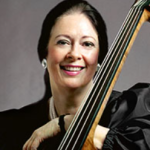 Orin O’Brien, bass (click for bio and to view this interview as a stand-alone story to share)
Orin O’Brien, bass (click for bio and to view this interview as a stand-alone story to share)
I studied piano from age six until I left L.A. for NY at age 19. (My first years of piano teachers were not very effective: since my parents were not musicians, they did not know where to look. And we moved a lot, due to WW II.) When I got to public high school, the first assembly had a performance by the school orchestra featuring the Rondo Capriccioso by Saint Saëns. I ran up to the conductor afterwards and asked if I could join the orchestra — he said they needed bassists and told me I could borrow a school bass: if I took lessons for six months, I could join the orchestra. I was absolutely hooked when I began to play with them.
My bass teacher in California was Milton Kestenbaum, who recommended that I go to NY to study. He let me play next to him in the Pasadena Symphony for two years, which showed me exactly how to play in an orchestra. But my most inspirational teacher was Frederick Zimmermann, then a member of the NY Philharmonic. It was he that insisted that I apply to audition for the Phil back when it did not have any women. So I did, and eventually Leonard Bernstein made the decision – it was solely his decision to make – and I was in.
When I came to Juilliard in 1954, I began ushering at Carnegie Hall (for $3.45 a night) and got to hear the NY Phil perform every week — it was a great education. Two years later, I was lucky to join the New York City Ballet Orchestra. There were many great musicians who found a home there after the NBC Symphony disbanded.
My wonderful teachers didn’t treat me any differently from the men they taught, and all my terrific bass colleagues helped me succeed. I was very lucky in my teachers and in all the great musicians I worked with and I would just like to say a big “thank you” to all those musicians who inspired and encouraged me and were kind to a “newcomer” in their group….sharing music is a beautiful way to live.
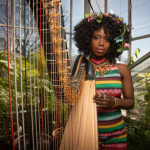 Brandee Younger, harp (click for bio and to view this interview as a stand-alone story to share)
Brandee Younger, harp (click for bio and to view this interview as a stand-alone story to share)
I took up the harp at about age 11 after meeting a colleague of my father’s who played harp. At some point in this meeting, she uttered the words “scholarship possibilities” and that was all my parents needed to hear! So I began harp lessons.
I had so many important influences in my life and career, beginning with our marching band director in high school. I actually played trombone in the band. He taught me how to memorize music quickly and the importance of discipline and of self-presentation. We would go to concert band competitions where we were the only Black band. He would say to always remember “they see you before they hear you”. At the time, it was a pain to have to be better dressed than the other kids, but I do acknowledge the wisdom of it now.
My other influence during my high school years was my harp teacher, Karen Strauss. I was already leaning towards pop but no one out there that I knew was doing it. So, I’d bring a CD of some pop tune that I’d heard and loved to a lesson and Karen would arrange it for harp so I could learn it. She always supported my musical choices.
Through my family, I began hearing of a woman named Sarah Lawrence who was a harpist of color. That was, and still is, pretty rare. And she was trying to make a career as a harpist, while encountering many challenges. I met and have remained close with her and always rely on her support and encouragement in achieving what she could not.
Finally, along the way, I discovered the recordings of Alice Coltrane and Dorothy Ashby, two of the great 20th century jazz harpists. First, I dug the sounds these women created on their recordings – like nothing I’d heard before. And then they were both black women! My experience of harpists to this point was I was the outlier: everyone else (teachers, fellow students, recording artists) was white. These two jazz women were a revelation.
It’s hard to narrow down the incredible things I’ve already experienced in my career, but here are a few:
In 2007, I performed at Alice Coltrane’s memorial at the Cathedral of St. John in NY. Then, in 2019, I played Toni Morrison’s memorial, also at St John. Oprah Winfrey was one of the speakers. Was I really on stage with Oprah? It was a “pinch me” moment. That year, the grand opening of The Shed at Hudson Yards was a month-long “Soundtrack of America” series curated by Quincy Jones and Steve McQueen. Again I was star-struck. I appeared three times on that series and had several meaningful conversations with Jones. He was an inspiring presence and surprisingly knowledgeable about the harp!
Finally, in 2022, I became the first Black woman to be nominated for a Grammy for instrumental composition. While I was thrilled, I was also disappointed. It’s 2022 and I’m the first? It felt like it should have happened sooner.
I never experienced any resistance or mistrust from colleagues. But on the business side of things, I have. Crews, tech people and producers can assume problems when I perform. I am conscious of needing to behave differently with them from the way I behave with friends or colleagues. I have to be really clear and informed about any non-musical needs I have and I have to limit my needs as much as I can. No playing diva! Is it because I’m a woman? Because I’m Black? Because I’m a harpist? All three may inspire a sub-conscious knee-jerk “here comes trouble” reaction. Producers worry I’m too expensive. Will I need a private dressing room? Will they need to rent me a harp? If I’m the only woman on the gig, will I need my own hotel room? I’ve learned that these are the areas in which I have to be “careful”. More so than my male counterparts.
And one last thing: I’m very excited that my new album Brand New Life will be released next month (April). It features previously unrecorded compositions of Dorothy Ashby’s. I’m paying tribute to one of my early life heroes. What a thrill!
Sara Cutler and Martha Hyde both serve on the Local 802 Executive Board and the Communications Subcommittee.
